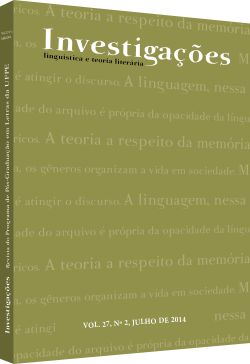Simetrias e assimetrias no mapeamento de sequências consonantais iniciais em português e em catalão
Abstract
Em português e em catalão, a distância mínima de sonoridade entre consoantes em ataque complexo é +3. Encontros consonantais (ECs) tautossilábicos sem essa distância são desfeitos por epêntese ou apagamento. Conforme a Teoria da Otimidade, observamos que restrições de marcação proibindo ECs tautossilábicos com distância de sonoridade superior a +2, ocupam posição alta nos rankings das duas línguas. Para satisfação dessas restrições, violações das restrições de fidelidade são necessárias. Neste trabalho, mostramos o ranqueamento dessas restrições para dar conta das simetrias e assimetrias dos ECs nas línguas em análise.
References
BECKMAN, Jill. 1998. Positional Faithfulness. Doctoral dissertation. University of Massachusetts Amherst, Amherst, MA.
BONET, Eulalia; LLORET, Maria-Rosa. 1998. Fonologia catalana. Barcelona: Ariel Linguística.
COLLISCHONN, Gisela. 2002. A epêntese vocálica no português do Sul do Brasil. In: BISOL, L.; BRESCANCINI, C. (Org). Fonologia e variação: recortes do português brasileiro. Porto Alegre: EDIPUCRS.
GOUSKOVA, Maria. 2004. Relational hierarchies in Optimality Theory: the case of syllable contact. Phonology 21, 201-250.
LANDMAN, Meredith. 1999. Morphological Contiguity. In: CARPENTER, A.; COETZEE, A.; DE LACY, P. Papers in Optimality Theory II: UMOP 26. GLSA: UMass-Amherst.
MATEUS, Maria Helena; D’ANDRADE, Ernesto. 2000. The phonology of Portuguese. Oxford University Press.
MCCARTHY, John. 2008. Doing Optimality Theory: applying theory to data. Blackwell.
______; PRINCE, Alan. 1995. Faithfulness and reduplicative identity. In: BECKMAN, J.; WALSH DICKEY, L.; URBANCZYK, S. Urbanczyk (eds). University of Massachusetts Occasional Papers in Linguistics 18.
PRINCE, Alan; SMOLENSKY, Paul. 1993 [2004]. Optimality Theory: Constraint Interaction in Generative Grammar. Malden, MA & Oxford: Blackwell.
Downloads
Published
How to Cite
Issue
Section
License
Copyright (c) 2015 Tatiana Keller

This work is licensed under a Creative Commons Attribution 4.0 International License.
Authors who publish with Revista Investigações agree to the following terms:
Authors retain copyright and grant the journal right of first publication with the work simultaneously licensed under the Creative Commons Attribution 4.0 International (CC BY 4.0) license that allows others to share the work with an acknowledgement of the work's authorship and initial publication in this journal.
Authors are able to enter into separate, additional contractual arrangements for the non-exclusive distribution of the journal's published version of the work (e.g., post it to an institutional repository or publish it in a book), with an acknowledgement of its initial publication in this journal.
You are free to:
Share — copy and redistribute the material in any medium or format for any purpose, even commercially.
Adapt — remix, transform, and build upon the material for any purpose, even commercially.
The licensor cannot revoke these freedoms as long as you follow the license terms.
Under the following terms:
Attribution — You must give appropriate credit , provide a link to the license, and indicate if changes were made . You may do so in any reasonable manner, but not in any way that suggests the licensor endorses you or your use.
No additional restrictions — You may not apply legal terms or technological measures that legally restrict others from doing anything the license permits.

